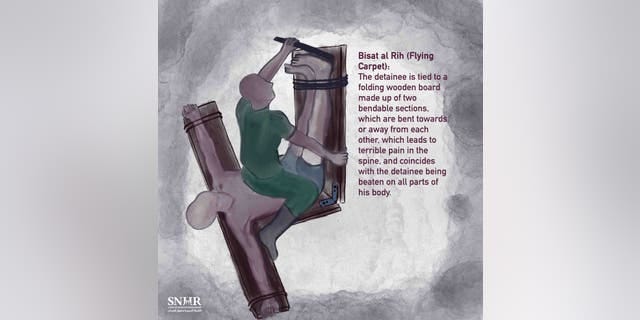“I am no bird; and no net ensnares me: I am a free human being with an independent will.”
― Charlotte Brontë, Jane Eyre
It has taken a decade, but this week finally brought some semblance of justice for millions of embattled Syrians who have lost those they loved most in the world at the hands of the Assad regime.
This past week, Syrian colonel Anwar Raslan was convicted by a German court of crimes against humanity regarding his oversight at a prison in Damascus. He was sentenced to life behind bars.
According to prosecutors, Raslan directed operations at the Al-Khatib facility in Damascus, where protesters and others suspected of opposing Syria's regime were held. During his tenure there, Raslan carried out 58 murders, tortured some 4,000 people, and is further accused of raping and sexual assaulting several hundred prisoners. Raslan, 58, defected from the Syrian regime in 2012 and sought asylum in Germany in 2014.
The news prompted me to go back through my filings, having documented the horrific human rights abuses in Syrian jails over the years. Although difficult to read, I do not believe in sanitizing war and want to share with you some of the testimonies from those who endured and survived life inside these chilling dungeons…
SYRIAN REGIME ACCUSED OF DOZENS OF TORTURE METHODS FROM 'CRUCIFIXION' TO RAPE TO EYE-GOUGING
When the Syrian revolution began in 2011, Muna Mohamed was a schoolteacher in Deir Ez-Zor, a city in eastern Syria.
As protesters took to the streets seeking democracy and a change in the Bashar Assad regime, she took a lead in the media wing, distributing leaflets and crafting statements for the opposition.
Then her world and her dignity were ripped apart.
Muna was arrested three times over the next few years – beaten with an iron rod, electrocuted, told she must die, repeatedly threatened with rape, and kept in solitary confinement.
“I saw an old man stripped naked and beaten until he fainted, they arrested my sister, my teen brother, and my aunt in search of me,” Muna, 31, told me from exile. “I still live the nightmares in my sleep. There are more than 200,000 detainees, and thousands more are disappeared. Friends of mine have been gone for nine years in the prisons.”
Muna considers herself to be one of the lucky ones.
A plethora of dirty dungeon prisons have already claimed thousands of lives. Many more still languish and are subjected to harrowing methods of abuse on a daily basis that the world has not been able to stop.
According to the Syrian Network for Human Rights, a global non-profit that has compiled the most comprehensive torture report to date, more than 14,000 people have been killed inside the government-run "hospitals" and detention facilities.
The report shows that 14,298 people - including 178 children and 63 women - died from torture in Syria between March 2011 and September 2019.
Syrian government forces are alleged to have killed over 14,000 victims while Islamic extremists slain 57 victims through torture. A further 43 lives were taken by armed opposition groups, another 47 were slaughtered by the Syrian Democratic Forces (SDF), and an additional 20 were killed by unknown parties.
Focusing specifically on the torture practices of the Damascus regime, the new report has identified a total of 72 methods of torture carried out against detainees.
There are 39 methods categorized in the report as "physical torture systemically practiced against Syrians in the regime's detention centers."
Among the horrifying methods used are pouring boiling hot water on the victim's abdomen and back, drowning, and suffocating. There is also torture with electricity, such as beating detainees with an electric baton directed at their abdomen or reproductive system, tying them to a metal chair with restraints, and delivering a shock to the whole body, which causes serious nerve damage, involuntary tremors, and permanent trembling.
There are a variety of forms of burn torture documented in the report, including the use of flames, chemical aids, oil, insecticides, and even gunpowder ignited onto the victim's body. In other cases, victims are alleged to have been hung for days in various degrees of suspension, often whipped and lashed as their bodies dangle.
The prohibition of movement is also highlighted as a form of torture. Often, prisoners are forced to squat, stand on one foot, and wedge themselves into tires for hours and days, enduring beatings and severe spinal injuries. As well as this, SNHR documents the use of the flying carpet, a board made up of two bendable sections, which can be bent towards or away from one another, causing severe spinal injuries to the detainee.
Another method is known as "The Crucifixion." The detainee's hands and feet are tied to a cross "in a grotesque imitation of crucifixion, before the beating begins, which is particularly harsh on the reproductive organs."
It is just the tip of the iceberg when it comes to the conditions in Syrian government prisons.
As well as crushing the head, smashing teeth, pulling out nails and gouging the eyes, garden shears are used to cut off body parts including reproductive organs, and staples are used to fasten noses, ears, and lips together.
“Detainees suffer unspeakably in the Syrian regime’s detention centers. The detainee’s clothes are often worn, soiled, ragged, and torn as a result of beatings. This is the primary contributor to the spread of illness, disease epidemics, and infections,” the report stated. “And because of the narrowness of cells and overcrowding, detainees must take turns to stand, sit and sleep.”
In addition, SNHR specifies six forms of torture within the context of the neglect of health care and conditions of detention. Detainees are denied access to medicine and treatment, deprived of bathing, toilet, and hygiene facilities, and stripped of clothes and blankets. They are routinely stacked so closely together that they are piled on top of one another, and dispossessed of food and sleep.
Sexual violence remains a major concern.
Both men and women are forced to "strip naked during inspections or torture sessions to inflict as much harm as possible or to insult human dignity.” Others are subjected to "rape or tools being inserted in reproductive organs," and in some cases, detainees are even compelled to commit acts of sexual abuse and even rape fellow prisoners.
A variety of psychological torture methods are also used. These range from forcing detainees to replicate animals' behavior with a rope tied around their neck, to forcing them to watch and hear the cries of the tortured echo through hollow walls, to keeping deceased detainees' bodies in cells, or forcing others to carry them as a means of inducing trauma and maximizing suffering.
Detainees may also be transferred to military hospitals, which comes with their own atrocities. There are instances in which doctors are forced to "punish the detainee for his wounds and broken bones," and "treat him without sterilization and denying him analgesics and medicine."
In 2014, a regime defector leaked the "Caesar photographs," revealing the hidden horrors of the regime. The disguised defector brought to Washington more than 55,000 graphic photographs - their authenticity confirmed by the FBI - and testified to the brutal torture occurring in his homeland. However, his calls for action have gone mostly unheeded.
Instead of curbing human rights abuses in the face of the global outcry for justice, SNHR investigators claim "the regime supported the officers who issued the torture orders, promoted them to senior positions, and used other state institutions as part of its torture machine."
“We have taken high risk for our lives and the lives of our families when we left Syria at the beginning of the Syrian revolution," “Caesar,” who remains in hiding, told me several years ago. “We had great hope that the world that claims freedom and humanity would end the bloodshed in Syria, and work to stop the killing and torture inside the Syrian prisons.”
As part of the SNHR's ongoing inquiry into Caesar photographs, SNHR has poured over 6,189 photographs to "determine the identity and give closure to his or her relatives."
Due to the prison mistreatment, some former inmates have been crippled and brain-damaged. The report includes additional testimony from former detainees, who describe incidents such as one where a child was sprayed with insecticide and set on fire before his body was wrapped in gauze, "and from time to time, they (security) lifted the gauze, peeled his skin with a knife."
Other incidents involved medical students extracting bone from victims and applying external fixation devices.
“It is civilian protection and accountability,” SNHR Founder Fadel Abdul Ghany said sadly. “What has happened to Syrians when it comes to these torture crimes amounts to extermination.”
20 YEARS LATER, WHAT’S GOING ON AT GUANTANAMO BAY?
Despite the end of the two-decade war in Afghanistan amid mayhem and madness with the American withdrawal in late summer, the temporary home for “enemy combatants” continues. This past week marks twenty years since the first detainees arrived at the Guantanamo Bay detention center in Cuba – disappearing into a murky facility defined by coil-topped fences and towers set against a banal landscape.
Currently, Gitmo maintains just 39 men, a stark reduction from the nearly 800 who have passed through its doors. Only 12 people have been charged with war crimes, including five who face trial for their roles in the attacks of September 11. Military Commissions have convicted just two in two decades.
And only two Afghans remain: Asadullah Harun Gul and Muhammed Rahim. The latter was one of the last known arrivals at Gitmo, and he was summoned there in 2008. He is considered a high-level al-Qaeda operative and is not recommended for parole. During Obama’s twilight days in office, six more Afghan detainees were released to Gulf countries.
Despite less coverage of Rahim in the media and limited information about him, he is one of the most sought-after individuals by the newly-installed Taliban regime. In the opinion of a close Rahim relative, a high-ranking Kabul intelligence official working under the guise of the Interior Minister, Siraj Haqqani, he is the most likely candidate for a prisoner swap.
In early 2020, an American Navy veteran turned civil engineer Mark Frerichs is believed to have absconded into the custody of the Haqqani Network.
“We have him,” the official said when I flashed a picture of Frerichs on my phone.
While he declined to show any further Frerichs proof-of-life, the case of Rahim – an English teacher who presumably worked as the interpreter for Usama bin Laden – was immediately emphasized, along with proclamations that Rahim with neither a member of al Qaeda nor the Taliban.
“He will never be charged – he is a ‘forever prisoner.’ He will never be charged because there is no evidence against him for being anything other than a simple Afghan villager,” Rahim’s former attorney, James Valentine, wrote to me. “There is no possibility of a prisoner exchange, because Mohammad Rahim was never a member of the Taliban. When the five Taliban prisoners were exchanged a few years ago for Bowe Bergdahl, Mohammad Rahim was never part of the package because he was never an important person. He derives from a very simple social background in a remote mountainous village.”
The detainee, now in his late sixties, appears in poor health, according to multiple sources. Valentine noted that Rahim’s “health is poor due to the long-term negative effects of his torture – including mangled wrists from hanging and digestive problems from long periods of food deprivation.”
“He has been diagnosed with cancer-like symptoms that require an MRI to make a complete diagnosis. The U.S. refuses to provide him an MRI exam,” Valentine asserted. “His only treatment is prayer and fasting, which he conducts to slow the growth of the cancer-like ‘nodules’ that exist in his body.”
U.S. intelligence officials I spoke to said there is no chance of the Afghan being considered for a prisoner swap. The matter remains a sore spot among the highest echelons of the Taliban and points to the dark cloud that has settled over the detention complex for two decades, with little end in sight.
It has been argued that the failure of the Obama administration to shut Gitmo has more to do with concerns about information subsequently becoming public about the CIA’s controversial “enhanced interrogation” program than it does with national security concerns.
“(Rahim) is being held simply because of the torture committed against him by specific individuals within the CIA, and to protect the countries that collaborated in the torture,” Valentine continued. “M.R.’s continued detention at Guantanamo Bay to conceal the crimes of torture committed against him is a violation of U.S. law, International Law and Human Rights, and a black page in American history.”
As it stands, 13 of the 39 detainees have been cleared for transfer and nine have died in custody – two from natural causes and seven from reported suicides. 27 have not faced criminal charges. 14 of the remaining detainees are Yemeni, followed by six Pakistanis, four Saudis, two from Mali, two from Afghanistan, two from Algeria and two from Libya. One each from Iraq, Indonesia, Tunisia, stateless Rohingya, Kenya, Somalia, and Palestinian Territories round out the existing prison population.
Throughout Gitmo’s long history of housing 50 nationalities, 29 percent of the population have been Afghan, followed by 17 percent Saudi, 15 percent Yemeni, and 3 percent Algerian.
Next year, 2023, will mark one hundred years since the U.S. inked an agreement with the freshly-independent Cuba to lease the infamous land for $2000 in gold annually. In 1934, a formal treaty was signed, handing Washington free reign to charter the island until a mutual withdrawal accord is attained.
Since the parcel was turned into a terrorist internment garrison amid the “War on Terror,” politicians and human rights groups have been pressing for its closure. The cost of running the facility is around $540 million annually, which means taxpayers are paying more than $13.8 million per remaining detainee. By comparison, it costs around $78,000 per year to sustain an individual under the Federal Bureau of Prisons.
CLICK TO READ MORE ABOUT WHAT IS GOING ON AT GITMO
In other news, please register for the event below…
For those interested in learning more about the aftermath of war, please pick up a copy of my latest book “Only Cry for the Living: Memos from Inside the ISIS Battlefield.”
Also if you want to support small business:
And also now available Down Under!
Thanks again for your support. Follow me on Instagram and Twitter for more updates

















Share this post